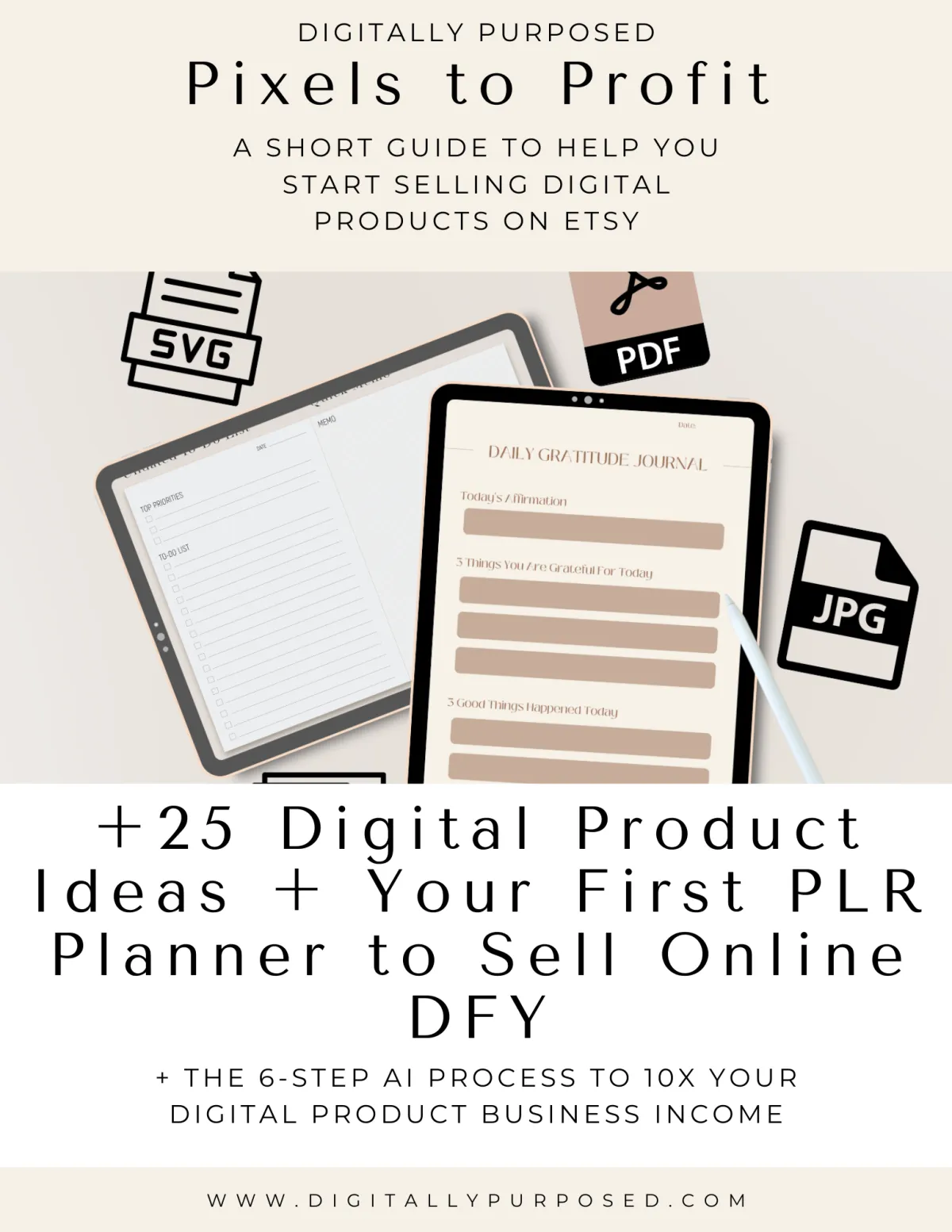BLOG
How To Sell Digital Products Online

What type of Etsy Shop will make you the most & fit your lifestyle the best?
Wondering what kind of Etsy shop you should start? There are several types: handmade, digital, and print-on-demand (or a hybrid combining two or more!)
With any shop type, always begin with research. I recommend using Everbee for audience and product research so you can find keywords with high search volume but lower competition, so your products are easier to find in search.
Next, you'll want to factor in critical differences in approach and process and know how difficult it is to get started. For example, a handmade shop requires a greater financial investment to start because you need physical inventory.
Let’s jump into these differences so you can determine what type of Etsy shop you should launch so you can begin making money each month and build up a great income stream that can even replace your day job (it did mine!).
Handmade Products
Handmade products were Etsy's classic bread-and-butter products for a long time and are still very popular. So many people want that unique, can’t-find-it-at-Target item that’ll have their friends asking where they got it, and handmade products are the perfect way to deliver this.
An Etsy shop selling handmade items focuses on customized, artistic, and unique items that you won’t find anywhere else, especially when it comes to customization. Think personalized mugs, wedding invitations, hand-crafted jewelry, high-quality phone cases, and many more products.
If you have a talent for sewing, crafting, designing, or building items, this is an excellent choice. Fewer people are selling handmade, artisan products on Etsy, which is now dominated by print-on-demand and digital products, so you immediately stand out from the crowd and can create a unique niche and following for your products.
Another pro for handmade products is that no one else can perfectly recreate something you design and craft, AND they can’t steal it easily. For example, there have been cases of other people downloading someone else’s digital products, “editing” them a bit, and then reselling them, which is really unethical if the product is for individual use only. This can be devastating to an Etsy business, and while there is recourse the seller can take, it’s a huge pain. If you make handmade products, someone can’t easily buy one and duplicate the product many times over to sell it, so you’re more protected in this sense.
The real challenge is managing large fluctuations in orders and shipping items efficiently. You need to invest quite a bit of money into your business up front, especially if you’re building large items like handcrafted wooden benches or creating pricey jewelry with high-quality stones.
Things like shipping and packing materials, the cost of shipping, and getting to the post office as quickly as possible are all critical to establishing your name on Etsy and getting good reviews (which are essential for all Etsy shop owners but especially important for sellers with more expensive items or handmade items that can’t be touched or examined like a shopper would have the chance to do in a physical store).
Print on Demand
Next is print on demand, or POD, which is a great hybrid between digital and physical products.
If you’re unfamiliar with the concept, it’s pretty straightforward.
Start by completing product and audience research with a tool like Everbee to find keywords and products with a high search volume and low competition. This step helps you determine a niche and product type. For example, you may specialize in t-shirts with mom jokes or mugs for dog parents. From there, use a keyword tool to find specific search terms that you can create a product for, make the product, and include these keywords in your title, product description, and tags to improve your SEO.
After choosing what product you want to sell, create a design using a tool like Canva, Adobe Illustrator, or even AI — you definitely don’t need to be artsy for this one. I’ve made thousands of dollars with print on demand and don’t have an artistic bone in my body.
Then, select a print-on-demand company, like Printful, which handles the physical product and prints your design onto it. You’ll link your Etsy account to the company so it automatically receives orders.
From there, every time a customer buys one of your POD products, the print-on-demand company starts processing the order. They handle inventory tracking, like having enough mugs on hand to satisfy demand, printing, shipping, and many even handle returns.
As you can see, there’s a ton of pros to this business model. Unlike a handmade Etsy shop, you don’t worry about inventory or keeping up with order processing, shipping, or returns. This saves you a lot of time and reduces the financial investment upfront. Plus, it’s a more low-risk business model because you don’t need to worry about being left with a bunch of mom joke t-shirts if they don’t sell. The print-on-demand company only creates the product once a customer places an order.
In terms of cons, you’ll want to consider how the POD company you’re working with charges. Some charge a flat fee for each product, while others charge based on the design’s complexity. You also have to consider your skill level in creating compelling designs. While you don’t need to be a graphic designer or artist, you need to dedicate time and a bit of money to software that allows you to create interesting, beautiful designs that’ll catch the attention of Etsy shoppers.
As for difficulty, a POD business is less challenging to launch than a handmade business because you don’t have to invest in inventory or handle shipping. You also don’t have a limit to how much you can sell. For example, if you can only create 50 handmade bracelets a week, that is the maximum you can sell on Etsy unless you hire help or reduce time spent on other obligations. With POD shops, there is no limit to how many t-shirts you can sell through the POD company unless you opt for personalization, which takes more of your time.
Digital Products
Our last Etsy shop is digital products. Digital products are one of my favorite types of Etsy stores because they are the most passive. In most cases, once you create and list the product, you can sell as many as you want at no extra cost. You just need to keep up with marketing, reviews, and customer questions.
You don’t need a lot of artistic talent, either. You can design them completely using tools like Kittl. It’s more about the product's functionality and aesthetic, which can be as simple or complex as you want, depending on your audience.
The downside to digital products is that many categories, such as digital planners or printables, have a lot of competition. However, this shouldn’t stop you from starting an Etsy shop. So often, I hear people say their shop isn’t doing well because there’s “too much competition” when really it’s the product and how they’re marketing it.
Etsy is a GIANT marketplace that receives more customers with every passing day. There are plenty of customers out there who would be interested in your meal planner printable. You just need to give yours a unique spin, a user-friendly design, and a nice aesthetic that appeals to your audience. For example, a meal planner printable for college students versus one for a busy mom with five kids. The latter will need to be more extensive, have room for more variation, and maybe include a printable grocery list. In contrast, the college student meal planner might have a fitness focus for someone tracking their macros, or it could have a fun aesthetic for something trendy like cottage core.
Remember, there is never a simple product. Design each product with a specific audience in mind. Put yourself in the buyer’s shoes and consider what would make their life easier. What should the product look like? Include? What doesn’t the product need?
Another con — Digital products can be easily copied. But, if someone copies your product, you can contest it with the retailer because any retailer worth their salt doesn’t want pirated products on their marketplace. Just keep all your receipts and add a watermark to your product image to shield yourself as much as possible.
However, the pros are HUGE for digital products. You can sell an unlimited number of them, and they appeal to many audiences and often have a lower price point, so it’s easier to convince people to buy them. Scalability is a big plus for this store and POD stores as a whole.
If you’re still reading and ready to move to the next step, then be sure to check out my masterclass 3 Ways to 5K Months on Etsy!

There are many ways to make a full-time income on Etsy, but which way is the RIGHT & FASTEST way for you?

FREE DOWNLOAD
Stuck for Digital Product Ideas?
Grab this free list of 25 digital products (+ the 6-step AI process to 10x your digital product business income) and where to create and sell them here.
© Copyright 2024 Digitally Purposed - Privacy Policy - Terms of Service - Disclosure
The term "Etsy" is a trademark of Etsy, Inc. This course content is intended for use on Etsy.com but is not endorsed or certified by Etsy, Inc.
